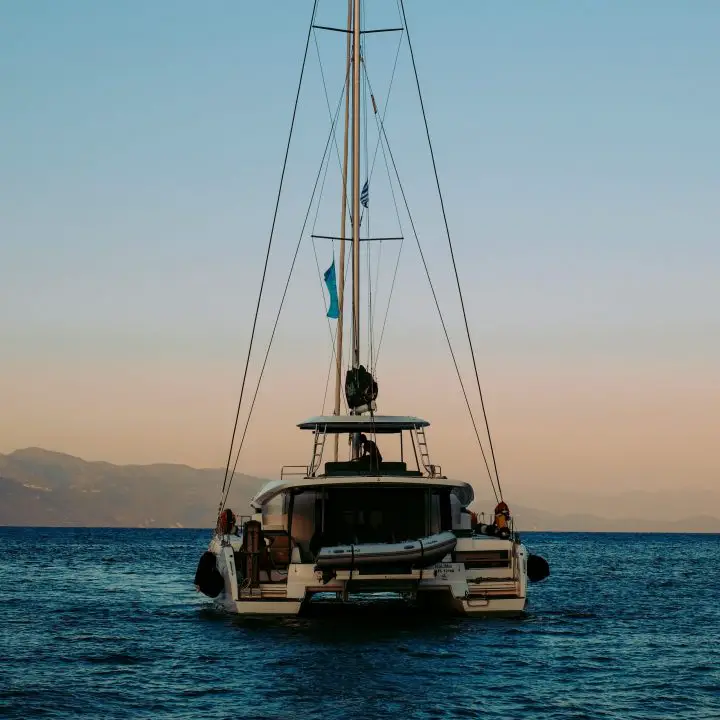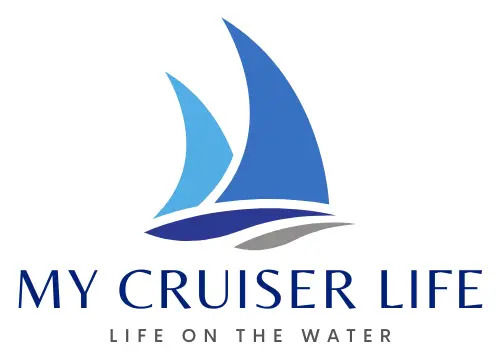A boat’s beam is the widest point of the boat. It’s an important measurement to know, just like the length of your boat is vital to know. Like many things in boat design, the beam is one of the tools that yacht designers tinker with to get just the right characteristics. But it also has lots of implications for boat owners too, so let’s take a closer look at a boat’s beam.
Table of Contents
- What is “Beam” on a Boat Exactly?
- Beam of the Boat and Boat Performance
- Traditional Beam Terminology
- Beam Impacts on a Boat
- Boat Design – Is More Beam Better?
- Wide Beam Boats
- Determining a Boat’s Beam
- Finding the Beam Sweet Spot
- FAQs (Frequently Asked Questions)

What is “Beam” on a Boat Exactly?
The beam of a boat is the widest point of the boat. It is usually located at the middle or slightly aft of the middle of the boat.
Beam of the Boat and Boat Performance
A boat’s beam impacts its performance in several ways:
- Stability: Wider beamed boats are generally more stable than narrower boats. They are less likely to capsize in waves.
- Speed and maneuverability: Narrower beamed boats are often faster and more maneuverable than wider boats.
- Comfort in waves: Narrower boats tend to slice through waves better, while wider boats are more likely to feel the impact of waves and chop.
- Living space: A wider beam provides more interior cabin space and storage capacity compared to a narrower boat of the same length.
- Trailering: Boats with beams under 8’6″ wide can be trailered on the road in most U.S. states without special permits. Wider boats may require permits.
Traditional Beam Terminology
Traditionally, boatbuilders used large wooden beams to create the boat’s frame. These beams ran laterally across the boat. As a result, a ship under construction looked like a massive ribcage, with support beams laid out. Boatbuilders would then add the rest of the wooden structure around the beam skeleton.
The center beam was usually the longest and thickest beam. This beam’s measurement was used to measure the width of the boat. Today, the word “beam” still refers to the boat’s widest point…although sometimes it’s not in the center and it’s seldom made of wood.
Boat Length and Beam
Smaller boats under 20 feet often have a two-to-one ratio. Your eight-foot dinghy will probably have a beam of about four feet. Boats over 30 feet have a bigger ratio, often about three-to-one, four-to-one, or five-to-one. A sailing monohull might be 40 feet long and 12 feet wide.
These are just estimates and rules of thumb, of course. A boat’s beam is one of those things carefully considered by yacht designers and manufacturers. They want just the right handling characteristics, speed, and stability.

Beam Impacts on a Boat
Today, when someone asks about your boat’s beam, they want to know how wide your boat is. Your boat’s beam can impact your navigation possibilities, your marina choices, the size and comfort of your living space, and your comfort at sea.
Beam and Marina Choices
Your boat’s beam can affect your marina options. Many marinas were built decades ago when narrower beamed boats were standard. Today’s more modern boats often have wider beams to provide a roomier feel in the cabin and give boaters more space. Older marinas might easily accommodate boats with a beam of 12 feet but may struggle to find a place for boats with larger beams.
If you have a large beamed boat such as a catamaran or trimaran, your marina choices will be even more limited. In addition, you might have a harder time finding a boatyard that can haul your boat and place it into dry storage. Many marina boat lifts are limited to hauling boats with beams less than 20 feet wide.
Beam and Cabin Size and Space
The larger the beam, the more space you’ll have in the boat’s cabin. If you are looking at liveaboard boats, you might be drawn to beamier boats with more space and storage options. Extra beam adds an enormous amount of space to the interior of the boat. This is one reason that trawlers and powerboats feel so much roomier than monohull sailboats–they have greater beams and they carry that beam all the way aft.
In sailboats, it’s a modern design trend to make beamier boats. Plus, the beam is carried much farther aft than in traditional designs, resulting in wide-open cockpits and large, flat transoms.
Beam and Navigation
The smaller your beam, the more places you can visit. In England, narrowboats have beams that are less than seven feet wide. These narrowboats can navigate England’s canal system. Some of England’s canal locks are very narrow, and only boats that can squeeze through seven-foot wide locks can successfully navigate these beautiful canals.
There are many other examples of a boat’s beam affecting a boater’s navigation possibilities. For example, some French canals can only accommodate beams of up to 15 feet. To successfully complete America’s Great Loop, boaters should use a boat that is less than 23 feet wide.
Related: Best Boat for the Great Loop
Beam and Stability
Boats with narrower beams are often faster, especially if they have a longer waterline. However, they might be less stable than a wide-beamed boat.
Boat Design – Is More Beam Better?
In many ways, the beam of a boat is a matter of personal taste. Here’s a look at the pros and cons of wide boats vs narrowboats.
Wide Boat Beams Pros
Wider boats are often more stable. For example, if you are looking for a stand-up fishing kayak, you’ll want a boat with a wider beam. A kayak with a narrow beam will be faster and more maneuverable but will be very hard to stand up on while keeping your balance.
Wider boats have more weight capacity than narrower boats of the same length. If you are hauling gear in your boat or need more room to spread out, a wider beamed boat might suit your needs better.
Wide Beam Boat Cons
If you trailer your boat, a boat with a wide beam might be more challenging to tow on the road. In most states, if your boat is wider than 8’6″ you’ll need a special permit to tow your boat on the road.
Many marinas are built with narrower boats in mind. Most marinas will find room for boats with beams less than 16 feet. Anything bigger, and you might struggle to find a traditional marina slip.
In addition, a wide beamed boat might be too wide for older canal systems.
Narrow Beam Boat Pros
A narrow beamed boat is often more maneuverable and faster. Have you ever seen an Olympic sculling race? These narrow, long boats can really fly! If you are looking for a fast, fun boat, look for a boat with a narrower beam. Narrow beamed boats are often better at slicing through waves and chopping, whereas wider beamed boats are more likely to feel every bump and wave.
Narrow Beam Boat Cons
Narrow beams have less storage capacity and less room. If you live on your boat or plan on sleeping on your boat overnight, you might find a narrow boat limiting.
Narrowboats are less stable and might feel more tippy than boats with wider beams.
Trailer Boat Beam
If you want to trailer a boat on the road in the US, you’ll want to consider its beam very carefully. Trailerable boats should generally have a beam of 8-feet 6-inches or less. Forty-seven states only allow trailered loads with an 8’6″ beam or less.
However, a few states allow wider loads without permits, so check your state’s regulations. Anything larger would be considered a wide load and require special permits and additional considerations. If you want to trailer a boat on the roadways easily, buy a boat that is less than 8’6″ wide.
Narrow Beam Boats
Narrowboats are long, narrow boats made for canal life. These boats have a beam that is less than seven feet to fit inside tiny locks easily.
Wide Beam Boats
Wide beam boats are more stable and less likely to capsize in waves. Modern boats are usually beamier than older, more traditional boats. Modern buyers are often looking for boats with extra space and condo-style amenities rather than small, camping-style interiors. If you are thinking about sleeping on your boat or living on your boat, consider how a wider beam will give you more space.
Catamarans
Catamarans are very popular cruising and charter boats. They have wide beams and offer couples and families additional space to spread out. In addition, their wide beam makes these boats very stable. These boats don’t heel as sailing monohulls do. This means that boaters can easily move around their boats while underway.
While monohulls and trawlers are often between 11 and 16 feet wide, cruising catamarans are usually between 21 and 26 feet wide. Monohulls vs catamarans is an ongoing debate, and of course, either choice involves compromise.

Trimarans
Trimarans are another style of popular wide beamed boat. These boats have three hulls and are even wider than catamarans. Cruising trimarans are up to 30 feet wide. If you have a larger trimaran, you’ll enjoy a stable ride but will have more trouble finding marina slips and haul-out yards.
Determining a Boat’s Beam
The easiest way to determine your boat’s beam is to refer to the boat’s documentation. If a factory-made your boat, you should have some paperwork that lists the boat’s beam. If your boat is Coast Guard documented, the boat’s measurements should be listed on that paperwork.
Measuring a Boat’s Beam
Measuring a boat’s beam might be easy or complex, depending on how big and complicated your boat is. If you have a 10-foot kayak, you can simply get a tape measure, find the widest part of the kayak, and note the measurement.
To measure a boat’s beam, first, you must determine the boat’s centerline. To do this, mark the center of the boat’s bow and the boat’s stern. Mark the centerline by tying a piece of string from the bow’s center to the stern’s center. Of course, if you have a sailboat or a boat with a bimini or other obstructions, this is easier said than done.
Now, find the widest point of the boat. The widest point is usually the middle of the boat or slightly aft of the middle of the boat. Now, measure the boat’s widest point, ensuring the measuring tape stays perpendicular to the centerline string.
Finding the Beam Sweet Spot
Consider your plans for your boat while you consider your boat’s beam. If you are looking for a stable kayak for fishing, find a nice, wide kayak. A dinghy that needs to haul several people and all the goodies should have a wide beam. A wider beam will give you more living and storage space if you are living aboard.
However, if you want a fast and maneuverable kayak, look for a kayak with a narrower beam. If you want a fast dinghy, consider a narrower one. If you want to boat in narrow canals or access small marinas, find a boat that has a narrower beam. Finally, if you want to trailer your boat, look for a boat that has a beam less than 8’6″.
Of course, the answer to finding the perfect boat that’s stable, trailers, crosses oceans, and stores all the stuff is quite simple. You just need a flotilla of different boats!
FAQs (Frequently Asked Questions)
Where is a boats beam?
The boat’s beam is its widest point. The widest point on a boat is usually in the middle or slightly aft of the middle of the boat.
How do you measure a boats beam?
First, mark the boat’s centerline from bow to stern. Next, find the widest point of your boat and measure it, making sure that the measuring tape is perpendicular to the centerline.
What does beam on trailer mean?
A trailerable boat should have a beam of 8-feet 6-inches or less. Most states require wider beamed boats to have a special permit and follow special regulations. If your boat’s beam is 8’6″ or less, you won’t need a special permit to trailer it on the road.
